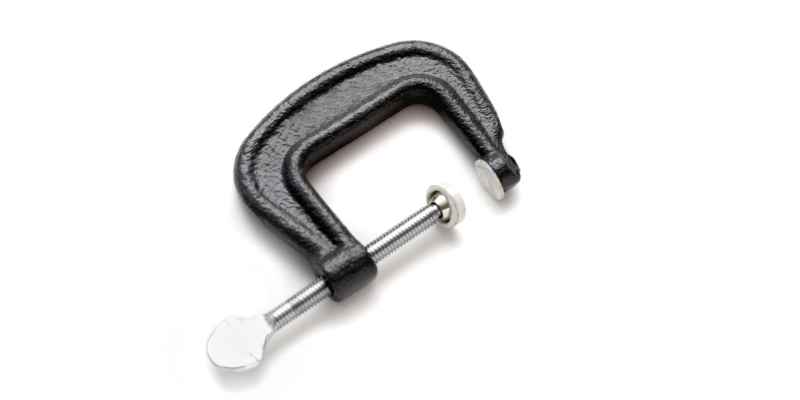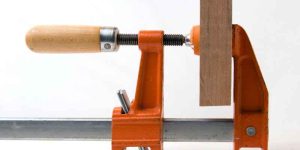To clamp wood without a clamp, you can use alternative methods such as using heavy objects or rope to secure the wood together tightly. These methods provide pressure to hold the wood in place while the glue dries.
Additionally, using woodworking tools like a mallet and chisel can help create joints that hold the pieces together without the need for clamps. These techniques are useful for DIY projects or when clamps are not available. By exploring creative solutions, you can successfully clamp wood without traditional clamps, ensuring your woodworking projects are completed efficiently.
Introduction To Clamping Wood
Importance Of Secure Woodworking
Secure woodworking is crucial for ensuring the stability and durability of wooden projects. When working with wood, it’s essential to properly secure the pieces to prevent movement or misalignment during the assembly process. This is especially important for tasks such as gluing, clamping, and fastening, where even the slightest movement can lead to flawed results.
Challenges Without Traditional Clamps
Without traditional clamps, woodworkers face significant challenges in achieving the necessary pressure and stability for various woodworking tasks. The absence of reliable clamps can result in difficulties in keeping the wood pieces firmly together, leading to imprecise joinery and weakened structural integrity.
The Rope And Wedge Technique
The Rope and Wedge Technique is a simple yet effective method for clamping wood without a clamp. This age-old technique involves using a sturdy rope and wooden wedges to secure the wood firmly in place. Whether you’re a DIY enthusiast or a professional woodworker, mastering this technique can be incredibly useful when you don’t have access to traditional clamps.
Step-by-step Guide
Follow these simple steps to effectively clamp wood using the rope and wedge technique:
- Position the wood pieces together in the desired alignment.
- Place the wooden wedges along the joint to create pressure points.
- Securely tie the rope around the wood and wedges, ensuring a tight fit.
- Tighten the rope by twisting it to increase the pressure and hold the wood in place.
Tips For Maximum Hold
For a more secure hold when using the rope and wedge technique, consider the following tips:
- Use high-quality, durable rope to withstand the pressure.
- Ensure the wedges are placed strategically to exert even pressure along the joint.
- Twist the rope multiple times to maximize the clamping force.
- Regularly check the tightness of the rope to maintain a strong hold.
Utilizing Pipe Clamps
Assembling Your Own Pipe Clamp
Creating your own pipe clamp is a cost-effective solution for woodworking projects. Simply gather the necessary materials, including a length of pipe, two pipe clamps, and a set of end caps. Slide the pipe through the clamps and secure it in place with the end caps. This DIY approach provides a versatile and adjustable clamping option.
Advantages Of Pipe Clamps
- Versatility: Pipe clamps can accommodate various lengths of wood, providing flexibility for different projects.
- Cost-Effective: Assembling your own pipe clamp can be more budget-friendly than purchasing traditional clamps.
- Adjustability: The sliding nature of pipe clamps allows for easy adjustments to fit the specific dimensions of the wood being worked on.
- Strength: The sturdy construction of pipe clamps enables them to exert significant pressure for secure clamping.
Wooden Bar Clamps

To clamp wood without a clamp, wooden bar clamps can be a great alternative. Simply place the wood between the two bars and tighten the screws to secure it in place. This method can be especially useful when working on larger projects that require extra pressure.
Wooden Bar Clamps are versatile tools for securing wood during various woodworking tasks. These clamps consist of a wooden bar with a mechanism to tighten and hold the wood in place securely.
Creating Your Bar Clamps
To make your own wooden bar clamps, gather materials like sturdy wooden bars, screws, and wingnuts. Cut the wooden bars to desired lengths and attach the screws and wingnuts to create a movable jaw. Use these homemade bar clamps by adjusting the wingnuts to secure the wood.
Efficiency in Woodworking Tasks
Wooden bar clamps offer efficiency in woodworking by providing a cost-effective solution for clamping wood without traditional clamps. These DIY clamps are easy to customize and can be used for various projects, enhancing precision and stability in woodworking tasks.
Remember to adjust the wingnuts to tighten the clamp securely.
The Ratchet Strap Method
Discover the innovative Ratchet Strap Method for clamping wood without traditional clamps. Simply loop the strap around the wood pieces and tighten for a secure hold. An efficient and cost-effective solution for woodworking projects requiring sturdy clamping.
The Ratchet Strap Method is a quick and easy way to clamp wood without a clamp. This method involves using a ratchet strap, which is a type of strap that has a ratcheting mechanism that tightens the strap when the handle is turned. Here’s how to use ratchet straps for clamping wood:
How To Use Ratchet Straps
To use ratchet straps for clamping wood, follow these steps:
- Place the wood pieces that need to be clamped together.
- Wrap the ratchet strap around the wood pieces, making sure that the strap is tight and secure.
- Insert the end of the strap into the ratchet mechanism and start ratcheting the strap until it is tight enough to hold the wood pieces together.
- Once the wood pieces are clamped together, tighten the ratchet strap a bit more to ensure a secure hold.
Precautions And Best Practices
When using ratchet straps for clamping wood, it’s important to keep these precautions and best practices in mind:
- Make sure that the ratchet strap is rated for the weight of the wood pieces you are clamping together.
- Always wear gloves when tightening the ratchet strap to prevent injury.
- Ensure that the ratchet strap is centered over the wood pieces to prevent uneven pressure.
- Check the ratchet strap periodically to make sure that it is still tight and secure.
Overall, the ratchet strap method is a simple and effective way to clamp wood without a clamp. Just make sure to follow these steps and precautions to ensure a safe and successful clamping experience.
Using Weights And Gravity
To clamp wood without a clamp, you can use weights and gravity to hold the pieces together while the glue sets. By stacking heavy objects on top of the wood or using a downward force, you can create the pressure needed for a strong bond without a traditional clamp.
Choosing Appropriate Weights
Consider heavy objects like books, dumbbells, or bricks.
Setup For Effective Use
Place weights on top of wood evenly for secure clamping.
Edge Gluing Boards
To edge glue boards without a clamp, use strong adhesive and apply pressure using heavy objects like books or weights. Place the boards tightly together and apply the adhesive, then add weight on top to create pressure for a secure bond.
This method is effective for smaller woodworking projects.
Technique For Gluing Without Clamps
Edge gluing boards is a simple yet essential woodworking skill. But what if you don’t have clamps? Fear not, as there is a technique for gluing without clamps. First, ensure that the boards’ edges are square and free of debris. Apply glue to one edge and press it against the other board’s edge, making sure they are flush. Then, use a scrap piece of wood and a mallet or hammer to tap the joint together firmly. Repeat this process along the entire length of the boards, adding more glue as necessary.
Ensuring A Strong Bond
To ensure a strong bond, it’s important to apply even pressure along the entire length of the joint. A simple way to achieve this is by placing weights on top of the boards. You can use anything from books to bricks, as long as they are evenly distributed and won’t damage the wood. Alternatively, you can use clamps made from scrap wood. Cut two pieces of wood that are slightly longer than the boards and drill a hole in each end. Thread a piece of rope or twine through the holes and tie a knot. Place the clamps on top of the boards and tighten the rope until there is even pressure along the joint.
Summary
Edge gluing boards without clamps can be done with a simple tapping technique and the use of weights or homemade clamps. By following these tips, you can achieve a strong bond and complete your woodworking projects without investing in expensive clamps.
Creative Use Of Rubber Bands
Easily clamp wood without a clamp using rubber bands. Wrap the bands tightly around the wood to secure it in place for gluing or clamping. This creative method provides a simple and effective solution for woodworking projects.
Clamping wood is an essential part of woodworking, but not everyone has access to clamps. Fortunately, there are creative ways to clamp wood without a clamp, and rubber bands are one of them. Rubber bands offer an affordable and convenient solution for clamping smaller woodworking projects. In this article, we’ll explore the strengths and limitations of using rubber bands for clamping wood.
Rubber Bands For Smaller Projects
Rubber bands are ideal for clamping smaller woodworking projects, such as picture frames, jewelry boxes, and small furniture pieces. They are flexible and can be easily stretched to fit around the wood pieces to be clamped. Additionally, rubber bands are readily available and affordable, making them a convenient option for those who don’t have access to clamps.
Strengths And Limitations
Like any clamping method, rubber bands have their strengths and limitations. One of the main strengths of using rubber bands is their flexibility. Rubber bands can be used to clamp irregularly shaped objects and can conform to the contours of the wood pieces being clamped. Additionally, rubber bands can be used to apply pressure to specific areas of a project, making them ideal for delicate projects that require precise clamping.
However, rubber bands also have their limitations. They are not as strong as traditional clamps and may not provide enough pressure for larger woodworking projects. Additionally, rubber bands may leave marks on the wood if they are left on for too long or if they are too tight. Therefore, it is important to use caution when using rubber bands for clamping wood and to monitor the clamping pressure regularly.
In conclusion, rubber bands can be a creative and effective solution for clamping smaller woodworking projects. They are affordable, readily available, and flexible enough to conform to the contours of the wood pieces being clamped. However, it’s important to be aware of their limitations and to use caution when using rubber bands for clamping wood.
Conclusion: Embracing DIY Ingenuity
Embrace your DIY ingenuity by learning how to clamp wood without a clamp. Discover alternative methods that are easy to execute and allow you to complete your woodworking projects with precision and efficiency.
Summing Up DIY Clamping Methods
Using household items creatively can secure wood firmly without a traditional clamp.
- Alternative methods can be effective and resourceful.
- Innovative solutions are within reach of DIY enthusiasts.
- Thinking outside the box leads to successful clamping results.
Encouragement For Continuous Learning
Embrace the journey of learning through trial and error in your woodworking projects.
- Stay curious and explore different clamping techniques.
- Challenge yourself to find new ways to secure wood without a clamp.
- Celebrate your ingenuity and problem-solving skills.

Frequently Asked Questions
Can You Clamp Wood Without A Clamp?
Yes, you can clamp wood without a clamp using alternative methods such as using a rope or a belt to apply pressure, using wedges to hold the wood in place, or using weights to press down on the wood. These methods can be effective for smaller projects or when clamps are not readily available.
How Do I Use A Rope To Clamp Wood?
To clamp wood using a rope, start by positioning the wood pieces together. Then, wrap the rope tightly around the wood and tie it securely. Apply pressure by twisting the rope or pulling the ends tight and securing them. This will create tension and hold the wood pieces firmly together.
What Are Some Alternatives To Clamps For Woodworking?
Apart from clamps, there are several alternatives for woodworking. These include using rope or belts to apply pressure, using wedges to hold the wood in place, using weights or heavy objects to press down on the wood, or even using woodworking vises or hand screws to secure the wood.
How Can I Secure Wood Without Using Clamps?
If clamps are not available, you can secure wood by using alternative methods. One option is to use wedges to hold the wood in place. Another option is to use weights or heavy objects to press down on the wood and keep it secure.
Additionally, you can use woodworking vises or hand screws to hold the wood firmly in position.
Conclusion
Mastering the art of clamping wood without a clamp can be a game-changer for DIY enthusiasts and professionals alike. By utilizing alternative methods such as using ropes, wedges, or even gravity, you can achieve secure and reliable clamping without the need for expensive tools.
These techniques not only save money but also offer versatility and convenience. So, get creative, explore different options, and enjoy the satisfaction of successfully clamping wood without a clamp. Happy woodworking!


